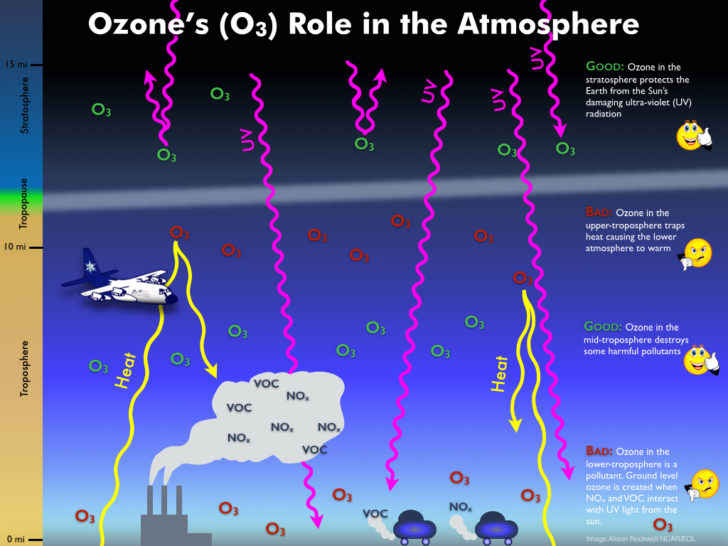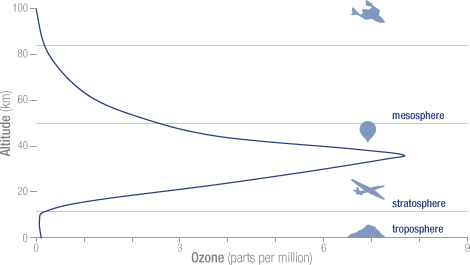New Model Allows Earlier, More Accurate Air Pollution Warnings
Special Stories
18 Nov 2019 1:33 AM
[UH] Researchers from the University of Houston have developed an artificial intelligence-based ozone forecasting system, which would allow local areas to predict ozone levels 24 hours in advance. That would improve health alerts for people at heightened risk of developing problems because of high ozone levels.
Yunsoo Choi, associate professor in the Department of Earth and Atmospheric Sciences and corresponding author for a paper explaining the work, said they built an artificially intelligent model using a convolutional neural network, which is able to take information from current conditions and accurately predict ozone levels for the next day. The work was published in the journal Neural Networks.
“If we know the conditions of today, we can predict the conditions of tomorrow,” Choi said.
 Ozone is an unstable gas, formed by a chemical reaction when sunlight combines with nitrogen oxides (NOx) and volatile organic compounds, both of which are found in automobile and industrial emissions. It can cause respiratory problems in people, and those especially susceptible to ozone – including people with asthma, the elderly and young children – are advised to reduce their exposure when ozone levels are high.
Alqamah Sayeed, first author on the paper and a Ph.D. student in Choi’s Air Quality Forecasting and Modeling Lab, said most current ozone forecasting models don’t incorporate artificial intelligence and can take several hours to predict future ozone levels, rather than just a few seconds for the new model. They also are less accurate; the researchers reported their model correctly predicted ozone levels 24 hours in advance between 85% and 90% of the time.
A key difference, Choi said, is the use of convolutional neural networks, networks capable of “sweeping” data and using that to form assumptions based on what it has learned. The convolutional networks are generally used to improve imaging resolution, he said. Choi and Sayeed said using the networks to extract information and then using artificial intelligence in order to make predictions from that data is a new application, illustrating the strength of the networks’ ability to gather information and make inferences based upon that information.
Ozone is an unstable gas, formed by a chemical reaction when sunlight combines with nitrogen oxides (NOx) and volatile organic compounds, both of which are found in automobile and industrial emissions. It can cause respiratory problems in people, and those especially susceptible to ozone – including people with asthma, the elderly and young children – are advised to reduce their exposure when ozone levels are high.
Alqamah Sayeed, first author on the paper and a Ph.D. student in Choi’s Air Quality Forecasting and Modeling Lab, said most current ozone forecasting models don’t incorporate artificial intelligence and can take several hours to predict future ozone levels, rather than just a few seconds for the new model. They also are less accurate; the researchers reported their model correctly predicted ozone levels 24 hours in advance between 85% and 90% of the time.
A key difference, Choi said, is the use of convolutional neural networks, networks capable of “sweeping” data and using that to form assumptions based on what it has learned. The convolutional networks are generally used to improve imaging resolution, he said. Choi and Sayeed said using the networks to extract information and then using artificial intelligence in order to make predictions from that data is a new application, illustrating the strength of the networks’ ability to gather information and make inferences based upon that information.
 [The concentration of ozone varies with altitude. Peak concentrations, an average of 8 molecules of ozone per million molecules in the atmosphere, occur between an altitude of 30 and 35 kilometers. From NASA]
The researchers used meteorological and air pollution data collected at 21 stations in Houston and elsewhere in Texas by the Texas Commission on Environmental Quality, representing conditions between 2014 and 2017. Sayeed said they programmed the convolutional neural networks using meteorological data – temperature, barometric pressure, wind speed and other variables – for each day, and added ozone measurements from each station for 2014, 2015 and 2016.
To test their belief that the model would be able to predict ozone levels given meteorological conditions from the previous day, they added weather data for 2017 and checked the forecasts the network produced for accuracy.
The model’s forecasts reached 90% accuracy, and Choi said it will become more accurate over time, as the network continues to learn.
[The concentration of ozone varies with altitude. Peak concentrations, an average of 8 molecules of ozone per million molecules in the atmosphere, occur between an altitude of 30 and 35 kilometers. From NASA]
The researchers used meteorological and air pollution data collected at 21 stations in Houston and elsewhere in Texas by the Texas Commission on Environmental Quality, representing conditions between 2014 and 2017. Sayeed said they programmed the convolutional neural networks using meteorological data – temperature, barometric pressure, wind speed and other variables – for each day, and added ozone measurements from each station for 2014, 2015 and 2016.
To test their belief that the model would be able to predict ozone levels given meteorological conditions from the previous day, they added weather data for 2017 and checked the forecasts the network produced for accuracy.
The model’s forecasts reached 90% accuracy, and Choi said it will become more accurate over time, as the network continues to learn.
 [Yunsoo Choi, left, associate professor in the Department of Earth and Atmospheric Sciences at UH, and Ph.D. student Alqamah Sayeed explain a new model to better predict ozone levels.]
Although the tests were done using Texas data, the researchers said the model could be used anywhere in the world. “The U.S. is geographically different from East Asia,” Choi said, “but the physics and chemistry of ozone creation are the same.”
Sayeed said the researchers are currently working to expand the model to include predictions of other types of pollutants, including particulate matter, as well as to extend the time period beyond 24 hours.
[Yunsoo Choi, left, associate professor in the Department of Earth and Atmospheric Sciences at UH, and Ph.D. student Alqamah Sayeed explain a new model to better predict ozone levels.]
Although the tests were done using Texas data, the researchers said the model could be used anywhere in the world. “The U.S. is geographically different from East Asia,” Choi said, “but the physics and chemistry of ozone creation are the same.”
Sayeed said the researchers are currently working to expand the model to include predictions of other types of pollutants, including particulate matter, as well as to extend the time period beyond 24 hours.
 Ozone is an unstable gas, formed by a chemical reaction when sunlight combines with nitrogen oxides (NOx) and volatile organic compounds, both of which are found in automobile and industrial emissions. It can cause respiratory problems in people, and those especially susceptible to ozone – including people with asthma, the elderly and young children – are advised to reduce their exposure when ozone levels are high.
Alqamah Sayeed, first author on the paper and a Ph.D. student in Choi’s Air Quality Forecasting and Modeling Lab, said most current ozone forecasting models don’t incorporate artificial intelligence and can take several hours to predict future ozone levels, rather than just a few seconds for the new model. They also are less accurate; the researchers reported their model correctly predicted ozone levels 24 hours in advance between 85% and 90% of the time.
A key difference, Choi said, is the use of convolutional neural networks, networks capable of “sweeping” data and using that to form assumptions based on what it has learned. The convolutional networks are generally used to improve imaging resolution, he said. Choi and Sayeed said using the networks to extract information and then using artificial intelligence in order to make predictions from that data is a new application, illustrating the strength of the networks’ ability to gather information and make inferences based upon that information.
Ozone is an unstable gas, formed by a chemical reaction when sunlight combines with nitrogen oxides (NOx) and volatile organic compounds, both of which are found in automobile and industrial emissions. It can cause respiratory problems in people, and those especially susceptible to ozone – including people with asthma, the elderly and young children – are advised to reduce their exposure when ozone levels are high.
Alqamah Sayeed, first author on the paper and a Ph.D. student in Choi’s Air Quality Forecasting and Modeling Lab, said most current ozone forecasting models don’t incorporate artificial intelligence and can take several hours to predict future ozone levels, rather than just a few seconds for the new model. They also are less accurate; the researchers reported their model correctly predicted ozone levels 24 hours in advance between 85% and 90% of the time.
A key difference, Choi said, is the use of convolutional neural networks, networks capable of “sweeping” data and using that to form assumptions based on what it has learned. The convolutional networks are generally used to improve imaging resolution, he said. Choi and Sayeed said using the networks to extract information and then using artificial intelligence in order to make predictions from that data is a new application, illustrating the strength of the networks’ ability to gather information and make inferences based upon that information.
 [The concentration of ozone varies with altitude. Peak concentrations, an average of 8 molecules of ozone per million molecules in the atmosphere, occur between an altitude of 30 and 35 kilometers. From NASA]
The researchers used meteorological and air pollution data collected at 21 stations in Houston and elsewhere in Texas by the Texas Commission on Environmental Quality, representing conditions between 2014 and 2017. Sayeed said they programmed the convolutional neural networks using meteorological data – temperature, barometric pressure, wind speed and other variables – for each day, and added ozone measurements from each station for 2014, 2015 and 2016.
To test their belief that the model would be able to predict ozone levels given meteorological conditions from the previous day, they added weather data for 2017 and checked the forecasts the network produced for accuracy.
The model’s forecasts reached 90% accuracy, and Choi said it will become more accurate over time, as the network continues to learn.
[The concentration of ozone varies with altitude. Peak concentrations, an average of 8 molecules of ozone per million molecules in the atmosphere, occur between an altitude of 30 and 35 kilometers. From NASA]
The researchers used meteorological and air pollution data collected at 21 stations in Houston and elsewhere in Texas by the Texas Commission on Environmental Quality, representing conditions between 2014 and 2017. Sayeed said they programmed the convolutional neural networks using meteorological data – temperature, barometric pressure, wind speed and other variables – for each day, and added ozone measurements from each station for 2014, 2015 and 2016.
To test their belief that the model would be able to predict ozone levels given meteorological conditions from the previous day, they added weather data for 2017 and checked the forecasts the network produced for accuracy.
The model’s forecasts reached 90% accuracy, and Choi said it will become more accurate over time, as the network continues to learn.
 [Yunsoo Choi, left, associate professor in the Department of Earth and Atmospheric Sciences at UH, and Ph.D. student Alqamah Sayeed explain a new model to better predict ozone levels.]
Although the tests were done using Texas data, the researchers said the model could be used anywhere in the world. “The U.S. is geographically different from East Asia,” Choi said, “but the physics and chemistry of ozone creation are the same.”
Sayeed said the researchers are currently working to expand the model to include predictions of other types of pollutants, including particulate matter, as well as to extend the time period beyond 24 hours.
[Yunsoo Choi, left, associate professor in the Department of Earth and Atmospheric Sciences at UH, and Ph.D. student Alqamah Sayeed explain a new model to better predict ozone levels.]
Although the tests were done using Texas data, the researchers said the model could be used anywhere in the world. “The U.S. is geographically different from East Asia,” Choi said, “but the physics and chemistry of ozone creation are the same.”
Sayeed said the researchers are currently working to expand the model to include predictions of other types of pollutants, including particulate matter, as well as to extend the time period beyond 24 hours.
All Weather News
More